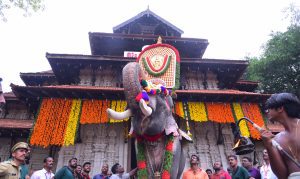Elephant lovers say relaxed laws can help temples, individuals buy healthy elephants from outside, while animal rights groups say they are abused.

Residents of Kalpathy in Palakkad provide water to an elephant being paraded at a temple festival (File pic/PS Manoj)
Thara was 90-plus years old when she died over two weeks ago in Punnathoorkotta, near the temple town of Guruvayur in Kerala’s Thrissur district. She was the state’s longest-living captive elephant at the time.
Thara was one of the few female elephants paraded at annual festivities at Kerala’s famed temples till her death.
Also known as Gaja Muthassi or Grand Old She-Elephant, Thara was given to the famed Sri Krishna Temple in Guruvayur when she was four years old by K Damodaran, proprietor of the then-famous Kamala Circus Company, which was popular across the country for performing daring stunts.

Captive elephants cool themselves during a break from the festival parade in Thrissur. (Supplied)
Thara used to carry Swarnakolam, or a gilded replica of the deity, in ceremonial processions during the temple’s annual celebrations.
As a result, her death caused widespread grief among believers and elephant enthusiasts in Kerala.
“The elephant served Guruvayoorappan with zeal, and he never caused us any trouble. Thara always stayed peaceful and tranquil while bringing the idol for daily Sheeveli and other ancient temple rites,” said Guruvayur Devaswom Board head Dr VK Vijayan when contacted by South First.
Thara’s death also triggered fresh worries, especially with Kerala’s temple-festival season around the corner.
According to conservative estimates, over 10,000 temple festivals with mandated elephant parades take place in Kerala each year between January and June. The festivals begin in certain temples as early as the second half of December.
These festivals are now fast approaching. Rising at an equally fast pace are the organisers’ concerns due to the death of notable elephants like Thara, as well as the dwindling population of captive elephants in general.
According to the most recent data from the state’s Forest Department, the state now has 412 surviving captive elephants, 22 fewer than the previous year.
The figure was 547 in 2018, when the government began tracking the whereabouts of captive elephants. Animal rights groups say the majority of them died as a result of maltreatment and overwork.
Across Kerala, 32 such elephants perished in 2018 alone, putting a strain on the state’s remaining captive elephants. Since then, the pressure has been mounting with each passing year.

An elephant is being paraded at Thrissur Pooram. (Supplied)
While very few are dying as a result of age-related ailments, elephant lovers are concerned about the survival of relatively young captive elephants.
They claim that the pachyderms face serious health problems as a result of the high-decibel sounds of percussion music performed at festivals, severe stress, tedious travel (primarily in trucks), and a lack of adequate rest.
The remaining jumbos are also in dire straits due to advancing age and the rising temperatures with each passing year.
According to noted animal rights campaigner VK Venkitachalam, the jumbos’ musth (mating) season also overlaps with the summer temple festival season, which adds to their stress.
According to him, the majority of the captive elephants in the state are over 40 years old, and it is the government’s job to ensure their proper treatment and relaxation, as the average elephant’s life expectancy is 60 years.
Another tragic feature of the current bleak scenario is the scarcity of qualified elephants to parade at the festivals.
Only half of the 412 surviving captive elephants would be available for parading, as most females, those in poor health, and those on musth would be exempt.
Due to the high demand, each available “healthy” elephant would be forced to participate in at least 50 festivals this season.
Wildlife experts claim Kerala is known for mistreating captive elephants during the festival season, when they are forced to tread across bitumen-applied roadways and stand still at a single location for several hours.
Another issue that arises during transportation is the availability of essential fodder and water. An elephant requires approximately 200 litres of water per day, which is not always provided in captivity.
Because there are laws prohibiting interstate travel and the buying and selling of elephants, transporting captive elephants from other states to meet current demand is almost impossible.
G Krishnaprasad, president of the Kerala Elephant Owners’ Association, believes that the state should take steps to remove barriers to buying elephants from outside, as elephants are essential to practically all temple festivals in the state, notably the much-celebrated Thrissur Pooram.
During their annual festivities, many churches and mosques in Kerala also parade elephants.

An elephant is on parade at Thrissur Pooram. Photo supplied.
Mangalamkunnu Kesavan was one of the most popular elephants on show during annual temple festivities such as Thrissur Pooram till his demise last year.
The gorgeous beast, caparisoned and adorned with exquisite parasols, was in high demand.
Kesavan was destined to traverse the state and was paraded at temple festivals and church feasts for the enjoyment of so-called elephant lovers.
The constant travel, even during the hot summer months, took its toll on the animal, and Kesavan developed an acute foot condition, intestinal colic, and trunk paralysis.
Vekitachalam’s Elephant Task Force members reported that the majority of elderly elephants appeared weak and unresponsive to mahout commands while participating in festivals during the sweltering summer months.
According to Vekitachalam, no elephant should be paraded unless it has a fitness certificate from an expert veterinarian.
Among the notable parading elephants who died in the last five years were Mangalamkunnu Karnan, Paramekkavu Sreepadmanabhan, Guruvayur Padmanabhan, and Thiruvambady Sivakumar.
“This practice of elephant parades in churches and temples will vanish entirely in another decade,” Venkitachalam told South First.
Mangalamkunnu MA Haridas, Kesavan’s owner who lives in Mangalamkunnu village in Palakkad district, owned up to 18 elephants in 1996–98, making him one of the world’s largest individual owners. He now only has four.
“The Palakkad district had 58 elephants six years ago; now it has only 28,” Haridas explained to South First.
In the previous 15 years, more than 135 captive elephants in the state have perished due to maltreatment and overwork, according to a public interest complaint filed by an animal rights activist before the Supreme Court.
However, the Supreme Court urged the petitioner to file a complaint with the high court, stating that the justices there were more aware of the local situation and the implications.
According to Kerala Forest Department data, man-made wounds are one of the causes of captive elephant deaths.
According to the data, in the last decade, 16 elephants with evident injuries from poor treatment were confiscated from private owners and treated at the Kottur elephant rehabilitation camp in Thiruvananthapuram.
Mahouts inflict wounds on sensitive areas of the animal’s body, such as around the foot, sides of the hip, and above the tusk, to control them efficiently.
Ironically, these same elephants are given demigod status in Kerala, which is unheard of elsewhere in the country, and some of the more popular among them have fan bases comparable to movie stars.
Many elephant owners want the 1972 Wild Life (Protection) Act changed.
Kerala put a lot of pressure on the Parliamentary Committee on Environment, which was in charge of suggesting amendments to the Wild Life Act, to allow for the transfer of ownership and transport of elephants.
Section 43 of the Act stipulates that no person in possession of a captive animal may transfer it by sale, offer for sale, or any other commercial manner of consideration. Kerala wished to change this clause.

A view of captive elephants on display at Thrissur Pooram. (Supplied)
Instead of modifying the law, the committee suggested rigorous rules even for the surrender of captive elephants (handing over ownership to a trust or a temple without receiving any money).
Normally, this is done to avoid legal processes over the sale and purchase of elephants.
The committee also proposed a blanket prohibition on the transfer and transportation of elephants by anyone with an ownership certificate.
The Kerala Elephant Owners’ Federation has 32 members who all want laws relaxed so that more elephants from outside can parade in the state’s festivals.
Members also intend to meet with Union Minister for Environment and Forest Bhupendra Yadav to request that the Wild Life (Protection) Act be amended to allow for the ownership and interstate transfer of elephants.
Efforts would also be made to seek the prime minister’s intervention in preserving the traditional charm and attractiveness of festivities like Thrissur Pooram, where elephant parades are a vital part.
“The Union government had intervened in support of Jallikattu when Tamil Nadu put pressure on it,” Haridas said. “We expect something similar from the Union and state governments.”
When contacted by South First, Kerala’s Temple Affairs Minister K Radhakrishnan stated that he was aware of the gravity of the situation and would raise it with the Union government as soon as possible.
However, animal rights campaigner Venkatachalam claimed that illicit ownership transfers were taking place with the state government’s knowledge.
“There must be an immediate social audit of the health of all captive elephants,” he said in an interaction with South First.
Activists like Venkatachalam, who advocate for improved living circumstances for captive elephants, are opposed to bringing in more elephants from elsewhere, claiming they would be abused in the state.
“Money-minded owners are parading elephants on almost all festival occasions,” said campaigner Purushan Eloor. “They disregard the harsh weather conditions and excessive decibel levels of bursting firecrackers.”
What was worse, Eloor told South First, was that the elephants were now being paraded even for mundane events like housewarmings and engagements.
“Despite the so-called love of Keralites for elephants, they are often tethered under trees in captivity,” Venkatachalam said.
“During the rainy season, elephants are forced to stay in slush pools filled with their dung, urine, and rainwater. Such filthy environments contribute to the spread of diseases like tuberculosis. Many elephants in the state have died as a result of foot illness, tuberculosis, and impaction,” he added.
He was likewise not swayed by the practice of elephant worship. “It is not worship,” Venkatachalam argued. “It is a religious business, and an abusive one at that.”
Meanwhile, a temple at Irinjadapilly in Thrissur devised a novel solution to the vexing problem by introducing a robotic elephant. People for the Ethical Treatment of Animals (PETA) donated the robotic elephant to the temple.
The “robo elephant” stands 11 feet (3.3 metres) tall, weighs 800 kg (1,763.7 pounds), and is made of iron. It is named Irinjadapilly Raman.
PETA executives stated that they had persuaded eight more temple committees in Kerala to choose robotic elephants.

Jul 26, 2024

Jul 26, 2024

Jul 25, 2024

Jul 25, 2024

Jul 25, 2024

Jul 24, 2024